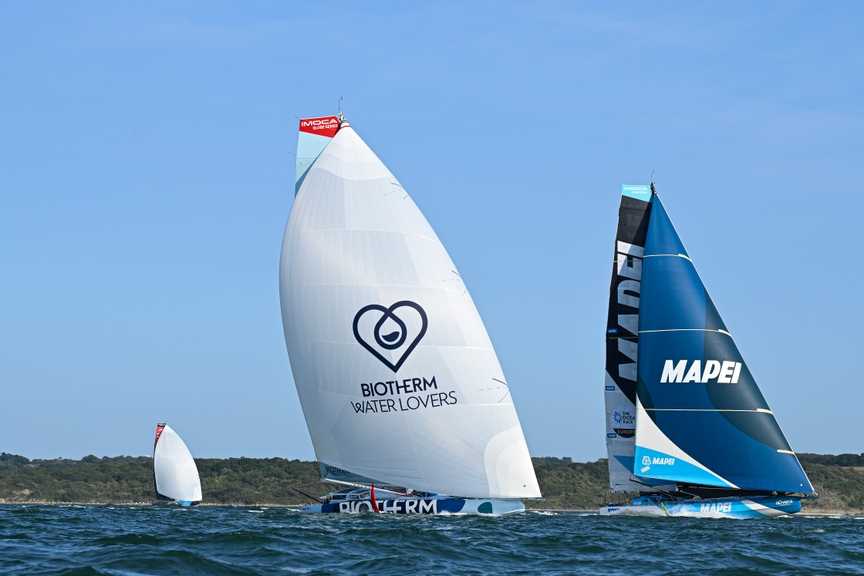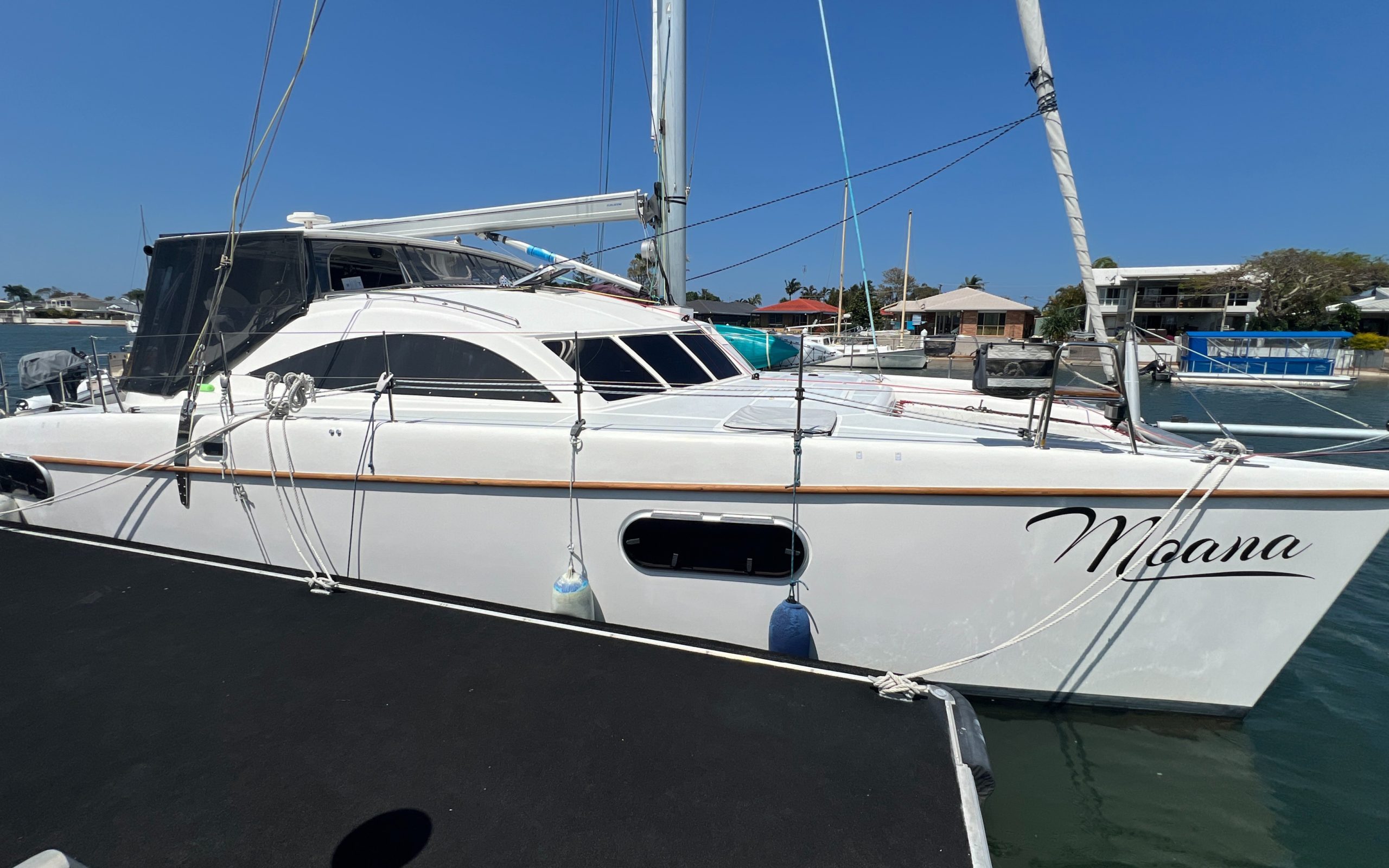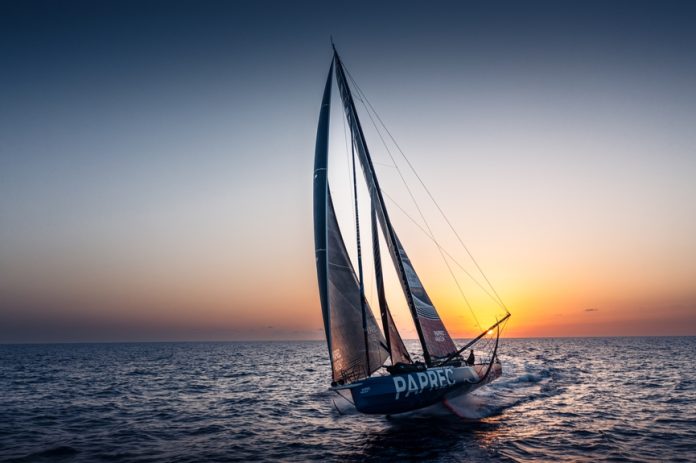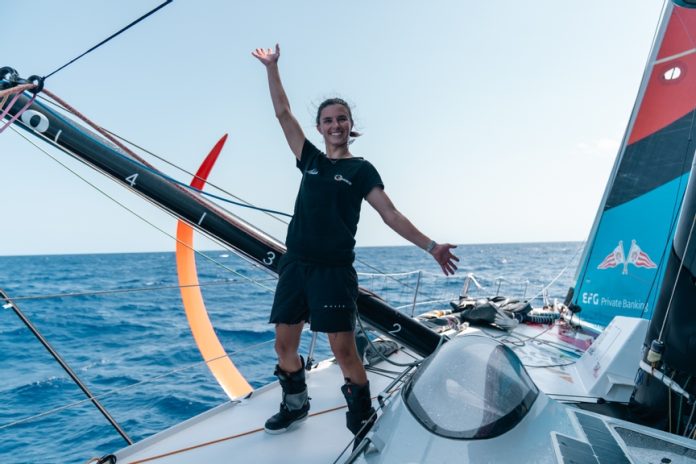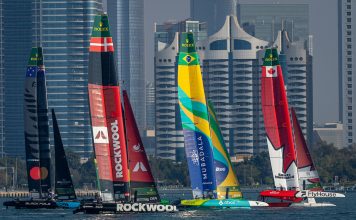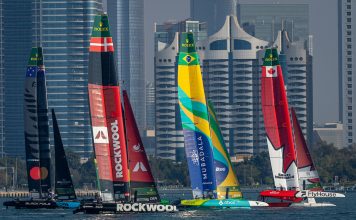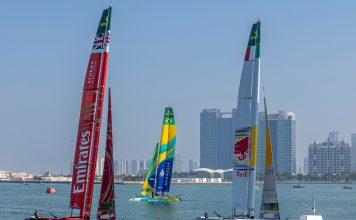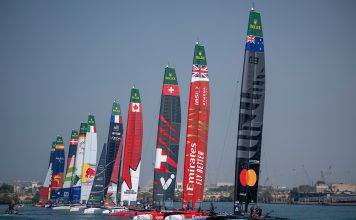A restart in historic waters
Bright sunshine bathed Gunwharf Quays on Sunday as the seven IMOCA crews prepared for the start of Leg 2. The parade of sailors, dock-out ceremony, and cheering crowds recalled the city’s role as the birthplace of the very first Whitbread Round the World Race in 1973.
By late afternoon the boats had paraded across to Cowes, where the Royal Yacht Squadron’s historic line provided the backdrop for a 1700 start. The Solent delivered near-perfect conditions: 10 to 14 knots of breeze, ebb tide helping the fleet downwind, spinnakers aloft, and the first scoring gate at The Needles looming just 12 miles away.
For Portsmouth, this was more than spectacle. It was living history, with the latest generation of offshore racers retracing the opening miles of the sport’s most storied event.
Holcim-PRB and Allagrande Mapei: repaired and ready
Just one week earlier, it looked unlikely that Holcim-PRB or Allagrande Mapei Racing would even make the start. Both boats had been holed in a high-speed collision just moments after the Kiel start of Leg 1, forcing retirements and frantic repairs.
For Rosalin Kuiper’s Holcim-PRB, the damage included a sizeable hole in the carbon hull and rigging failure. Within days the team, aided by Knierim Yachtbau shipyard, had designed, moulded, and fitted a new hull section. Technical crew worked in shifts through day and night.
Holcim-PRB’s collision and comeback in The Ocean Race Europe
Alan Roberts captured the feeling best: “Adversity either splits or unites you. In this case it united us. The shore team thrived on it. When we go offshore, we’re in a really focused, nothing-else-matters mindset, and that’s what they gave us.”
Allagrande Mapei’s skipper Ambrogio Beccaria was equally relieved: “We really thought it was over. Now that it’s behind us, it’s going to push us to give our very best.”
By Saturday both boats were tied up at Gunwharf Quays, repairs complete, their return already a victory.
Allagrande Mapei’s tough start in The Ocean Race Europe 2025
Early moves and the Needles gate
As the fleet charged down the Solent, it was Paprec Arkéa, skippered by Yoann Richomme, who nailed the start. Their blue and red IMOCA led the fleet across the Royal Yacht Squadron line, spinnaker filled, in a picture-perfect moment.
But by the Needles scoring gate it was again Biotherm, led by France’s Paul Meilhat, who seized maximum points. Paprec Arkéa took second, while Holcim-PRB, eager to prove their comeback, crossed third. Malizia and Canada Ocean Racing followed, with Allagrande Mapei and Amaala trailing.
For Biotherm, the points kept flowing — a perfect record across Leg 1 and both scoring gates so far, good enough to sit clear at the top of the provisional leaderboard.
A fresh start for the fleet
The importance of Leg 2 was written across the sailors’ faces on the Portsmouth dock.
Franck Cammas, sailing aboard Holcim-PRB, spoke of renewed focus: “We’re arriving fairly fresh and obviously very focused. It’s the longest leg and we’re going to face many different conditions. There will be a windy first night, then tough transitions. The result could be decided in the last 100 miles.”
For Allagrande Mapei, newcomer Morgan Lagravière was eager for his first Ocean Race leg: “We were all frustrated with Kiel, so now we’re really happy to be heading back to sea, measuring ourselves against the others.”
Paprec Arkéa’s Richomme, smiling before the start, described it simply: “A spinnaker start down the Solent, a fast run down the Channel — beautiful. Then a tactical crossing of the Bay of Biscay, Portuguese trades, and into Porto. It’s what I like for my boat.”
Tactical battlegrounds ahead
At over 1,000 nautical miles, Leg 2 is the longest and most complex stage of the 2025 edition. The course stretches from the Channel through the Bay of Biscay, down the Portuguese coast, and into the Mediterranean.
First came the sprint west, with winds forecast to build to over 30 knots as the fleet approached Brittany. The real test, however, lay in the transition zone near Ushant, where easterly winds would give way to light patches before filling again from the northwest.
“Versatility will be key,” said Holcim-PRB navigator Nicolas Lunven. “The forecast isn’t clear, so we’ll need to be very opportunistic. Big differences could open up in the transitions.”
The Matosinhos–Porto fly-by midweek will add spice. The three-hour neutralisation is unusual and could shake the pack apart. “It could be a jackpot, or it could be a handicap,” admitted Paprec’s Corentin Horeau.
Then comes Gibraltar, where winds funnel unpredictably through the strait, before the final push into the Mediterranean. “It should be very inconsistent,” Cammas said. “The result could be decided right at the end.”
Day one drama: light winds and compression
By Monday morning, the forecast had already delivered a curveball. After a fast night with boats exceeding routing predictions, the fleet compressed dramatically off Ushant as the wind collapsed below 10 knots.
Canada Ocean Racing briefly snatched the lead, only for Biotherm to claw back once pressure returned. For teams that gambled on the southern route, including Holcim-PRB and Allagrande Mapei, the calm proved costly.
“It’s a bit of a disappointment,” admitted Lagravière. “We thought we could sneak through, but it wasn’t the case. Still, we’re working hard to pick up the new wind.”
Biotherm’s Sam Goodchild described the scene bluntly: “The conditions are struggling to stabilise, it’s not super pleasant, but we’re doing everything to optimise speed.”
The leaderboard so far
After the Needles scoring gate, the provisional standings read:
- Biotherm – 11 points
- Paprec Arkéa – 7 points
- Team Malizia – 6 points
- Canada Ocean Racing – Be Water Positive – 4 points
- Team Amaala – 3 points
- Holcim-PRB – 0 points
- Allagrande Mapei Racing – 0 points
For Holcim-PRB and Allagrande Mapei, points matter less than proving they are back at full strength. As Roberts put it: “We’re not just back, we’re 100% ready — more ambitious than before.”
Looking ahead
From light-wind compressions to the explosive Bay of Biscay and the tricky trades of Portugal, the second leg promises to be a tactical chess match. The Mediterranean finish could deliver anything from glassy calm to sudden squalls, and skippers are unanimous that patience will be key.
As Lagravière summed it up: “You don’t need to fear anyone — we all know each other well — but you do need to be wary of everyone.”
For fans, Leg 2 is shaping as the most complete test yet of the 2025 edition — a true battle of the Atlantic, and a race that may only be decided in the final miles before Cartagena.








